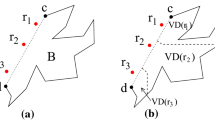Abstract
Most path planning problems among polygonal obstacles ask to find a path that avoids the obstacles and is optimal with respect to some measure or a combination of measures, for example an u-to-v shortest path of clearance at least c, where u and v are points in the free space and c is a positive constant. In practical applications, such as emergency interventions/evacuations and medical treatment planning, a number of u-to-v paths are suggested by experts and the question is whether such paths satisfy specific requirements, such as a given clearance from the obstacles. We address the following path query problem: Given a set S of m disjoint simple polygons in the plane, with a total of n vertices, preprocess them so that for a query consisting of a positive constant c and a simple polygonal path \(\pi \) with k vertices, from a point u to a point v in free space, where k is much smaller than n, one can quickly decide whether \(\pi \) has clearance at least c (that is, there is no polygonal obstacle within distance c of \(\pi \)). To do so, we show how to solve the following related problem: Given a set S of m simple polygons in \(\mathfrak {R}^{2}\), preprocess S into a data structure so that the polygon in S closest to a query line segment s can be reported quickly. We present an \(O(t \log n)\) time, O(t) space preprocessing, \(O((n / \sqrt{t}) \log ^{7/2} n)\) query time solution for this problem, for any \(n ^{1 + \epsilon } \le t \le n^{2}\). For a path with k segments, this results in \(O((n k / \sqrt{t}) \log ^{7/2} n)\) query time, which is a significant improvement over algorithms that can be derived from existing computational geometry methods when k is small.
Access this chapter
Tax calculation will be finalised at checkout
Purchases are for personal use only
Similar content being viewed by others
References
Agarwal, P.K., van Kreveld, M., Overmars, M.: Intersection queries for curved objects. In: Proceedings of the seventh annual symposium on Computational geometry, pp. 41–50. ACM (1991)
Agarwal, P.K., Sharir, M.: Ray shooting amidst convex polygons in 2D. J. Algorithms 21(3), 508–519 (1996)
Bespamyatnikh, S.: Computing closest points for segments. Int. J. Comput. Geom. Appl. 13(05), 419–438 (2003)
Bespamyatnikh, S., Snoeyink, J.: Queries with segments in Voronoi diagrams. In: Proceedings of the Tenth Annual ACM-SIAM Symposium on Discrete Algorithms, pp. 122–129. Society for Industrial and Applied Mathematics (1999)
Chazelle, B., et al.: Ray shooting in polygons using geodesic triangulations. Algorithmica 12(1), 54–68 (1994)
Cole, R., Yap, C.K.: Geometric retrieval problems. In: 24th Annual Symposium on Foundations of Computer Science, pp. 112–121. IEEE (1983)
Goswami, P.P., Das, S., Nandy, S.C.: Triangular range counting query in 2D and its application in finding k nearest neighbors of a line segment. Comput. Geom. 29(3), 163–175 (2004)
Kirkpatrick, D.: Optimal search in planar subdivisions. SIAM J. Comput. 12(1), 28–35 (1983)
Lee, D., Ching, Y., et al.: The power of geometric duality revisited. Info. Process. Lett. 21, 117–122 (1985)
Matoušek, J.: Efficient partition trees. Discret. Comput. Geom. 8(3), 315–334 (1992)
Matoušek, J.: Range searching with efficient hierarchical cuttings. Discret. Comput. Geom. 10(2), 157–182 (1993)
Mitchell, J.S.: Shortest paths among obstacles in the plane. Int. J. Comput. Geom. Appl. 6(03), 309–332 (1996)
Mitchell, J.S.: Geometric shortest paths and network optimization. Handb. Comput. Geom. 334, 633–702 (2000)
Mitra, P., Chaudhuri, B.: Efficiently computing the closest point to a query line1. Pattern Recognit. Lett. 19(11), 1027–1035 (1998)
Morimoto, T.K., Cerrolaza, J.J., Hsieh, M.H., Cleary, K., Okamura, A.M., Linguraru, M.G.: Design of patient-specific concentric tube robots using path planning from 3-D ultrasound. In: 2017 39th Annual International Conference of the IEEE Engineering in Medicine and Biology Society (EMBC), pp. 165–168. IEEE (2017)
Mukhopadhyay, A.: Using simplicial partitions to determine a closest point to a query line. Pattern Recognit. Lett. 24(12), 1915–1920 (2003)
Segal, M., Zeitlin, E.: Computing closest and farthest points for a query segment. Theor. Comput. Sci. 393(1–3), 294–300 (2008)
Storer, J.A., Reif, J.H.: Shortest paths in the plane with polygonal obstacles. J. ACM (JACM) 41(5), 982–1012 (1994)
Wein, R., Van Den Berg, J., Halperin, D.: Planning high-quality paths and corridors amidst obstacles. Int. J. Robot. Res. 27(11–12), 1213–1231 (2008)
Weina, R., van den Bergb, J.P., Halperina, D.: The visibility-voronoi complex and its applications. Comput. Geom. 36, 66–87 (2007)
Yap, C.K.: Ano (n logn) algorithm for the voronoi diagram of a set of simple curve segments. Discret. Comput. Geom. 2(4), 365–393 (1987)
Author information
Authors and Affiliations
Corresponding author
Editor information
Editors and Affiliations
Rights and permissions
Copyright information
© 2018 Springer Nature Switzerland AG
About this paper
Cite this paper
Daescu, O., Malik, H. (2018). Does a Robot Path Have Clearance C?. In: Kim, D., Uma, R., Zelikovsky, A. (eds) Combinatorial Optimization and Applications. COCOA 2018. Lecture Notes in Computer Science(), vol 11346. Springer, Cham. https://doi.org/10.1007/978-3-030-04651-4_34
Download citation
DOI: https://doi.org/10.1007/978-3-030-04651-4_34
Published:
Publisher Name: Springer, Cham
Print ISBN: 978-3-030-04650-7
Online ISBN: 978-3-030-04651-4
eBook Packages: Computer ScienceComputer Science (R0)




